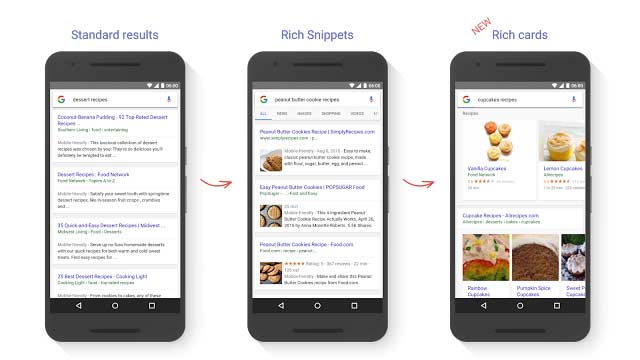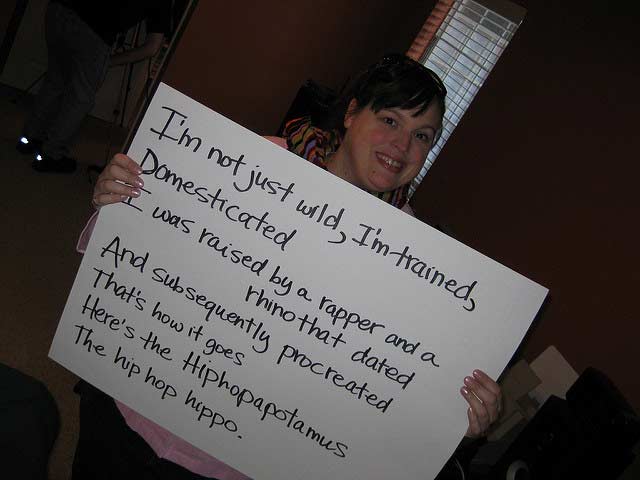Rich Cards & The Evolution of Google Search
Last month our friends at that big friendly search company unveiled their latest brainwave for richer and more engaging search results: Rich Cards. This new and improved method by which to present information relevant to particular search queries is the most recent addition to the increasingly cluttered Google search engine results page (SERP) and naturally will enrich and improve our lives by a factor of 16.* But what are rich cards, do we really need them and will Google ever stop meddling with how it displays search results?
If you’re waiting for an answer to the third question I’m afraid you’re out of luck because frankly nobody outside of Mountain View knows, but I can help you with the first…
What Are Rich Cards?
Anyone with an Android phone will recognise the format of the new rich cards coming soon to a mobile SERP near you, as they appear much like the “convenient” informational cards that are peppered around the search giant’s mobile operating system across apps such as Google Now, Google Photos and Google Drive. The thinking here is that they look and feel like cue cards – a concept no doubt alien to post-Millennial generations – acting as timely contextual visual prompts to aid you with your searching just like a physical cue card might aid your memory to recall your lines on stage, or prompt you during a speech.

Image source: Google Webmaster Central Blog
As with any update Google rolls out the official reasoning behind it is to improve search experience for the user but as any cynic will tell you what Google considers user-beneficial is only ever as a side effect of something being Google-beneficial. What’s more, it’s becoming increasingly apparent that “Google-beneficial” can be seen as roughly equivalent to “messing things up for everyone else” with each and every fresh iteration of the SERP eating into ever more screen real estate that was once reserved for the genuine organic listings we SEO sorts had typically worked so hard to occupy.
Using Google’s own example in the graphic above consider the three phases in the evolution of the mobile SERP where in the first image there are four regular websites immediately visible as results returned for the search query. All four of those immediately visible results can legitimately be considered targets for your website to attempt to occupy. They represent lovely obstacle-free routes for the user to reach their appropriate destination which is precisely why they’re so coveted.
Shifting SERPs
Rich cards are specific to mobile search results but this update is indicative of the Big G’s device-wide determination to handle all of your search queries without you ever leaving the clutches of their greedy personal-data-hungry embrace. It’s a trend that has been apparent across desktop searches for several years and it’s now more difficult than ever to actually find a search query that returns nothing but good old-fashioned straightforward links to sites, ordered 1-10, free of extraneous clutter.

Around the turn of the century when Google was still in its formative years a popular pastime for geeks was seeking combinations of two different words that would return only one single result. This jolly folly was termed a Googlewhack, as popularised in the UK by comedian Dave Gorman, but is today a near impossible task. The Internet has gotten too big and irregular words have been paired together on multiple occasions in every possible combination you could care to dream up, thus rendering the game redundant. Might I suggest its natural successor be that of seeking out the rare and unusual terms that return pure, unadulterated search results with no Google “enhanced” gubbins decorating the surrounding page landscape? For this is the true deep searcher’s prized find.
Whilst the casual search user will likely care little for the fact that their search results are one click closer with a rich card or a knowledge graph entry, the creators of the content Google is essentially lifting are the ones who lose out. It’s all very well having answers at your fingertips but creators of content as well as curators need credit where it’s due and if your site gets no traffic as a result of Google presenting your handiwork as if it came up with it all by itself then the motivation to keep going suddenly begins to wane.
This is particularly true of sites that rely on their visitor numbers to make the advertising revenue that keeps them going and this is where suddenly you begin to wonder whether Google have in fact shot themselves in the foot. If a site can’t survive without ad revenue and Google is preventing the site from receiving the traffic it needs for the ads to be served to, those ads cease to become of any use, and who was serving them in the first place… Why it was Google all along.

Down Down Deeper and Down
Time was when getting an organic ranking at position 10 was a page one ranking – something to shout about. But with so many additional elements to a typical SERP today you can often find that the tenth organic result doesn’t actually appear until halfway down the second page of results – you know, the page nobody ever clicks on. You’ve got the Google Local “three pack” (where a map of three potentially relevant local businesses is displayed), featured snippets (a nugget of relevant information pulled from a supposedly authoritative source), news results, social results, similar search query suggestions and we’re even being shown more ads before you get to the authentic organic stuff.
It’s a similar story on mobile devices, where screen real estate is far more precious, and where the aforementioned rich cards are set to dominate to the point where a traditional “number one” ranking could actually see your site appearing below the fold (the point after which one has to scroll to see more). As a consequence of all these additional elements interfering with the search results typical SEO measurement metrics have had to be adapted.
We can no longer claim a “page one ranking” for achieving the 9th organic listing spot and nor can we claim the title of “top spot” for being the first site ranked organically. Its gotten to the point where some agencies and SEO professionals have given up reporting on organic rankings all together, instead seeking alternative methods by which to measure the success of a campaign to improve “visibility”.
Of course Google cares not a jot for the difficulties faced by us in the SEO industry – after all we’re making money out of their customers – and to be fair, nor should they. But the moment the results they serve fail to satisfactorily resolve a user’s search query, be that through overpopulating the once uncluttered results page or by pandering to advertisers before end users, that’s when Google’s search market share may begin to erode. After all, there are some very capable alternatives in the likes of privacy-respecting DuckDuckGo, tree-planting Ecosia and fact-filled Wolfram|Alpha.

Image source: David Tomic via Flickr cc
Google’s not going anywhere just yet of course, but lest we forget how once the world seemed Nokia’s oyster, if ever we need reminding of how a dominant force can become a spent one within the blink of an eye.
Follow my contributions to the blog to find out more about SEO and digital trends, or sign up to the ThoughtShift Guest List, our monthly email, to keep up-to-date on all our blogposts, guides and events.
*Not actual statistic. Measurement not quantifiable.
